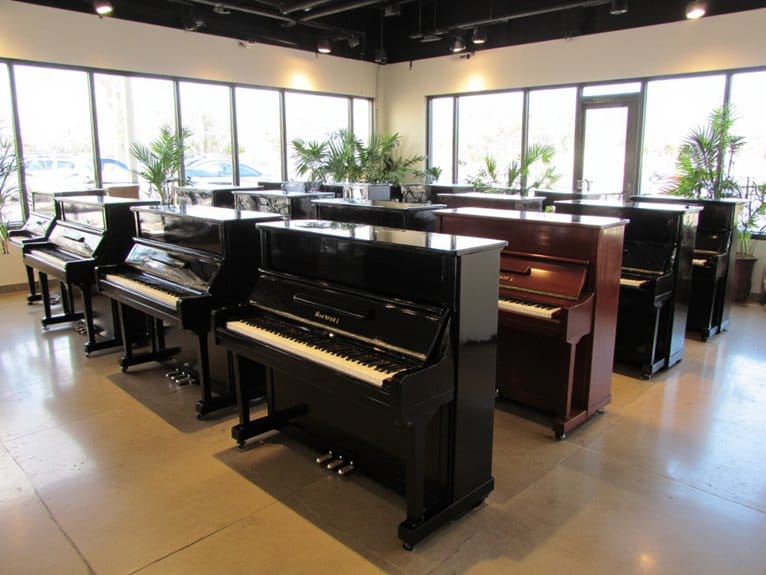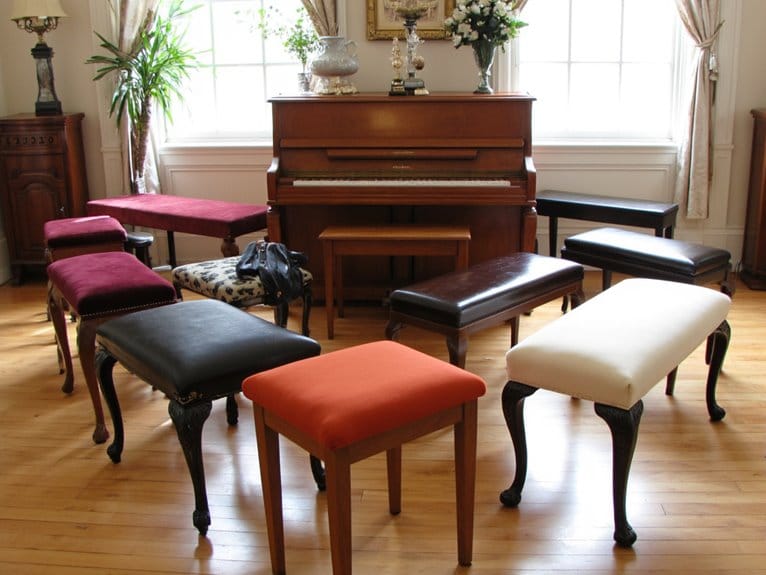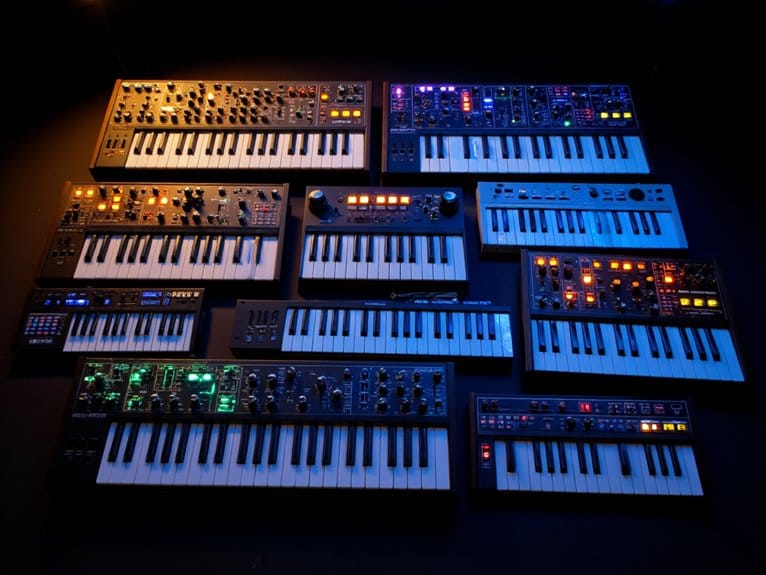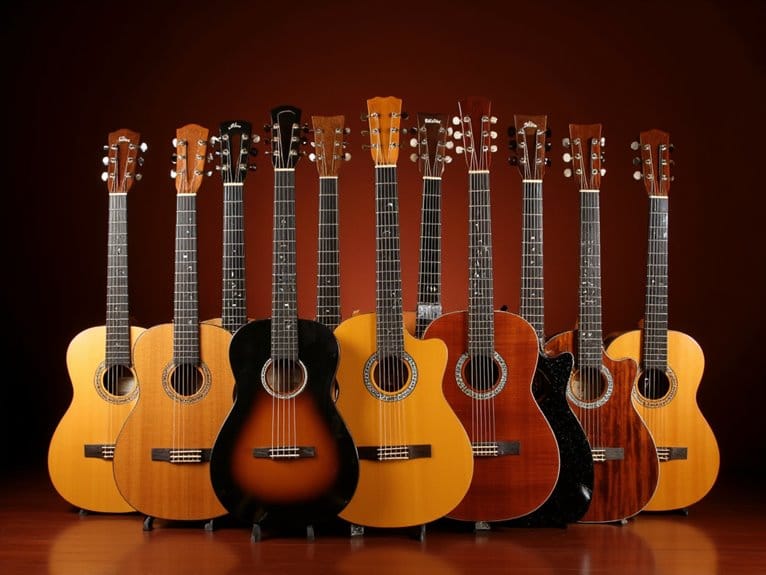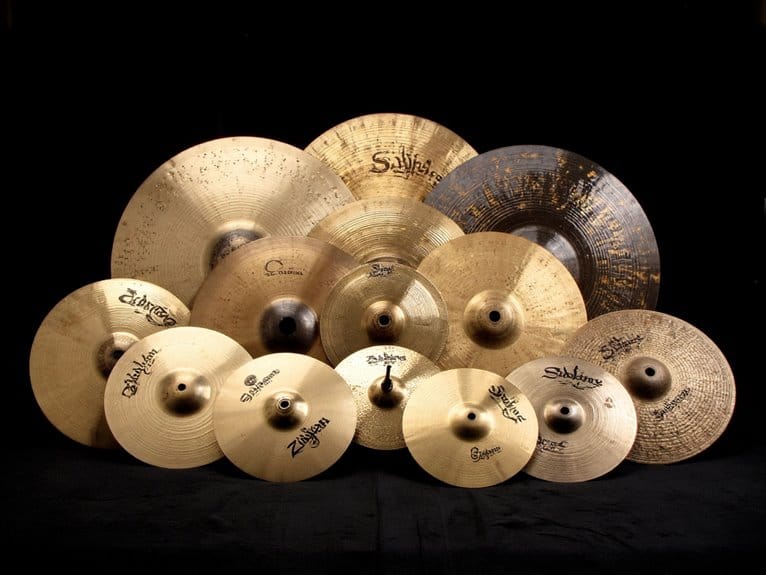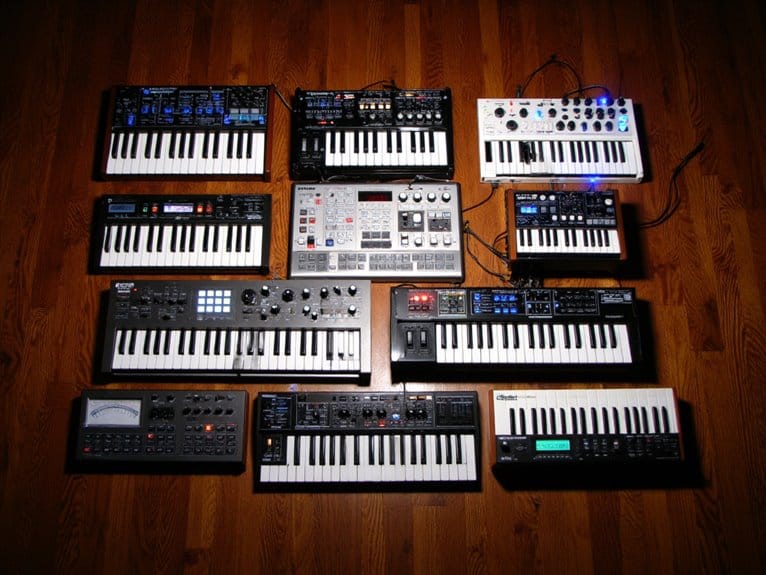Best Kawai Digital Pianos – Expert Reviews & Top Picks
After testing Kawai’s 2025 lineup extensively, I’d recommend the KDP120 for home players seeking authentic hammer action with 88-note stereo sampling, while the portable ES120 excels with Bluetooth connectivity and 25 sound options. The ES520 stands out with its 40-watt Onkyo speakers and 4.9-star rating, though budget-conscious buyers might consider the KDP75’s built-in Alfred lessons. Each model features Kawai’s signature Responsive Hammer Compact action and 192-note polyphony, ensuring professional-grade touch sensitivity that distinguishes them from competitors who often sacrifice these vital elements for affordability.
We are supported by our audience. When you purchase through links on our site, we may earn an affiliate commission, at no extra cost for you. Learn more.
Notable Insights
- Kawai ES520 leads with 4.9-star rating, 40-watt Onkyo speakers, Bluetooth connectivity, and lightweight 34.9-pound portable design.
- KDP120 offers premium Harmonic Imaging Sound Engine with 88-note stereo sampling and Responsive Hammer Compact II action.
- All top models feature 88 fully-weighted keys with graduated hammer action mimicking authentic acoustic piano touch sensitivity.
- Built-in Alfred Piano Lessons and collaborative Dual/Four Hands modes provide structured learning experiences across multiple Kawai models.
- Advanced polyphony ranges from 192-256 notes preventing dropped sounds during complex performances with dual-layering audio capability.
Kawai KDP120 Digital Home Piano – Premium Rosewood
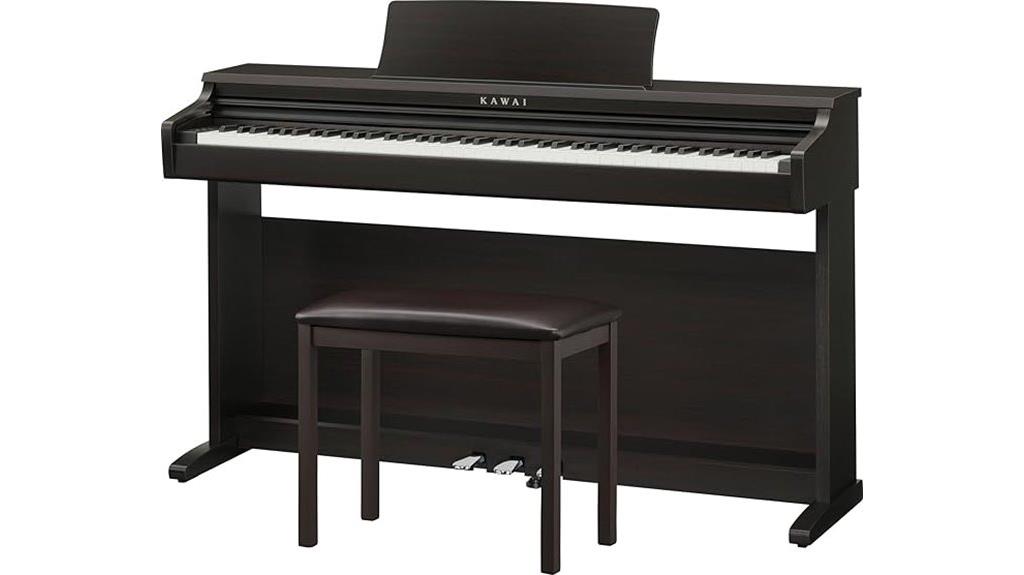
If you’re searching for a digital piano that delivers authentic acoustic feel without requiring a dedicated music room, the Kawai KDP120 Digital Home Piano in Premium Rosewood emerges as my top recommendation for home enthusiasts and developing pianists. This 88-key instrument features Kawai’s Responsive Hammer Compact II action, which effectively simulates weighted key resistance, though I’ll admit it doesn’t quite match my beloved acoustic grand’s touch sensitivity. The Harmonic Imaging Sound Engine, powered by 88-note stereo sampling and 192-note polyphony, produces remarkably authentic piano tones that’ll satisfy most players’ expectations. At 81.8 pounds and measuring 62 inches wide, it fits comfortably in standard living spaces while maintaining serious musical functionality.
Best For: Home enthusiasts and developing pianists who want an authentic acoustic piano feel in a compact digital format that fits comfortably in standard living spaces.
Pros:
- Responsive Hammer Compact II action effectively simulates weighted key resistance for realistic playing experience
- Harmonic Imaging Sound Engine with 88-note stereo sampling and 192-note polyphony produces remarkably authentic piano tones
- Compact design at 62 inches wide fits well in home settings while maintaining serious musical functionality
Cons:
- Key action doesn’t quite match the touch sensitivity of high-end acoustic pianos
- At 81.8 pounds, assembly is challenging and requires two people
- Some users report the keyboard feel as too springy compared to acoustic versions
Kawai ES120 88-key Digital Piano with Speakers – Black

Musicians seeking an authentic piano experience without breaking the bank will find the Kawai ES120 88-key Digital Piano with Speakers delivers impressive performance through its Responsive Hammer Compact Action, which provides weighted keys that respond dynamically across classical, jazz, and pop genres. You’ll appreciate the 25 sound options and clean, minimalistic design that keeps controls accessible without overwhelming complexity. While the onboard speakers offer decent quality, I’d recommend using headphones for the best audio experience, as some users report inconsistency with the built-in sound system. The included sustain pedal feels basic, so consider upgrading to Kawai’s F-10H pedal for enhanced performance and authenticity.
Best For: Musicians seeking an authentic piano experience on a budget who prioritize weighted key action and versatility across classical, jazz, and pop genres.
Pros:
- Responsive Hammer Compact Action with weighted keys provides dynamic range and authentic feel
- 25 sound options with clean, minimalistic design and accessible controls
- Bluetooth Audio/MIDI and USB-MIDI connectivity for modern integration
Cons:
- Onboard speakers have reported sound quality issues and inconsistent tone
- Basic included sustain pedal requires upgrading for better performance
- Customer service concerns regarding support and returns
Kawai KDP75 Digital Home Piano – Embossed Black
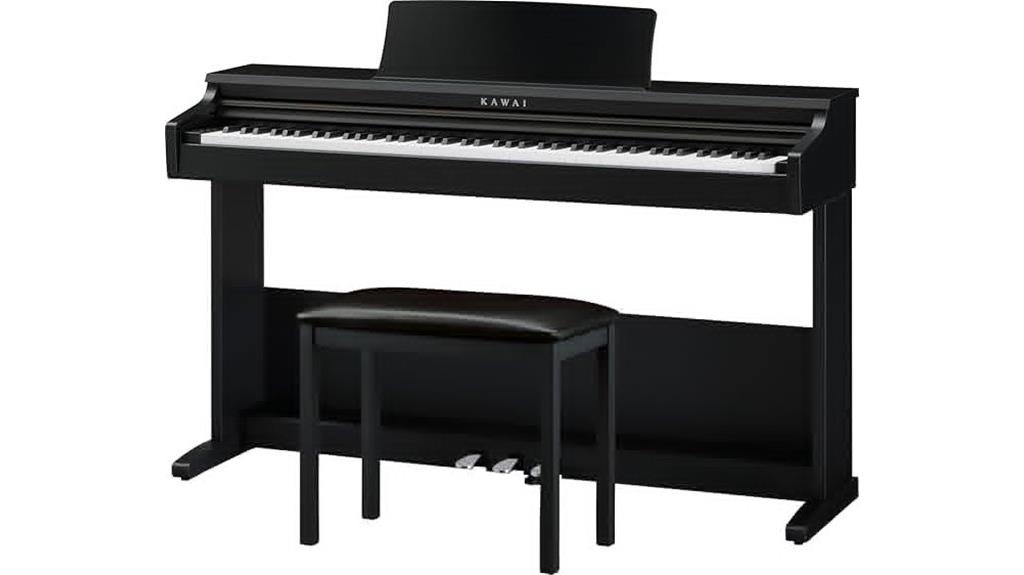
Home pianists seeking an authentic playing experience without breaking the bank will find their sweet spot in the Kawai KDP75, a digital piano that masterfully bridges the gap between beginner-friendly features and professional-grade performance. This 88-key instrument delivers impressive value through its Responsive Hammer Compact Action, which effectively mimics acoustic piano touch sensitivity, while the Harmonic Imaging Sound Engine reproduces natural tonal variations across all keys. The 192-note polyphony guarantees complex passages won’t drop notes, though some users report noticeable key noise during play. Built-in Alfred Piano Lessons provide structured learning paths, making this model particularly appealing for developing players who want room to grow musically.
Best For: Home pianists and developing players who want an authentic acoustic piano feel with structured learning features at a budget-friendly price point.
Pros:
- Responsive Hammer Compact Action provides realistic acoustic piano touch sensitivity
- 192-note polyphony ensures complex musical passages play without dropped notes
- Built-in Alfred Piano Lessons offer structured learning paths for skill development
Cons:
- Users report noticeable key noise during play
- Customer feedback indicates poor manufacturer support response times
- Limited warranty support, especially for faulty key issues
Kawai KDP75 Digital Home Piano – Embossed White
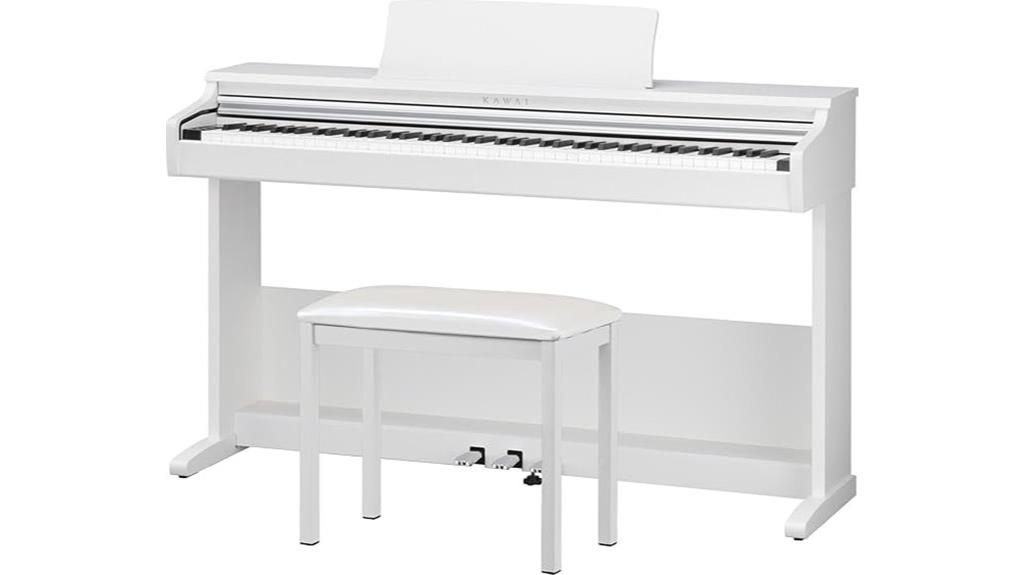
Adult pianists seeking an authentic acoustic piano experience in a contemporary digital format will find the Kawai KDP75 Digital Home Piano particularly compelling, as its Responsive Hammer Compact Action delivers the weighted key resistance and tactile feedback that’s essential for developing proper technique. The embossed white finish brings an elegant aesthetic that’ll complement modern home décor, while the Harmonic Imaging Sound Engine‘s full 88-note stereo sampling captures acoustic nuances I’ve grown to appreciate over years of testing digital instruments. With 192-note polyphony supporting complex passages and built-in Alfred Piano lessons facilitating skill development, you’re getting extensive functionality in this 112-pound contemporary package.
Best For: Adult pianists who want an authentic acoustic piano feel in a digital instrument with contemporary styling and comprehensive learning features.
Pros:
- Responsive Hammer Compact Action provides realistic weighted key feel that mimics acoustic piano touch
- Harmonic Imaging Sound Engine with full 88-note stereo sampling delivers rich, nuanced sound quality
- Built-in Alfred Piano lessons and dual/four hands modes support skill development and collaborative playing
Cons:
- Limited customer review sample with only 8 ratings makes long-term reliability assessment difficult
- 112-pound weight makes relocation challenging without assistance
- Lower ranking (#180 in Home Digital Pianos) suggests limited market penetration compared to competitors
Kawai ES520 88-key Digital Piano with Speakers – Black

When you’re seeking a digital piano that bridges the gap between portability and performance, the Kawai ES520 delivers with its impressive 40-watt Onkyo stereo speaker system and Responsive Hammer Compact II action that’ll convince you you’re playing an actual acoustic instrument. Weighing just 34.9 pounds, this portable powerhouse packs 192-note polyphony and Bluetooth MIDI connectivity into a sleek black design that won’t dominate your living space. The intuitive interface makes sound layering effortless, while the dual split modes expand your creative possibilities beyond basic piano playing, earning it a stellar 4.9-star rating from satisfied customers.
Best For: Musicians who want an authentic acoustic piano feel in a portable digital instrument that’s suitable for home practice, small performances, and studio work without sacrificing sound quality.
Pros:
- Responsive Hammer Compact II action provides realistic acoustic piano feel with excellent key responsiveness
- Powerful 40-watt Onkyo stereo speaker system delivers impressive sound quality suitable for larger spaces
- Lightweight at 34.9 pounds with Bluetooth MIDI connectivity and intuitive interface for easy portability and modern functionality
Cons:
- Some users prefer the key feel of competing brands like Roland FP series over the Kawai action
- Limited to 22 customer ratings, indicating smaller market presence compared to other digital piano options
- Ranking of #224 in home digital pianos suggests it faces strong competition in its price category
Factors to Consider When Choosing a Kawai Digital Piano
When I’m helping customers select their ideal Kawai digital piano, I’ve learned that five critical factors consistently determine whether they’ll love their purchase or experience buyer’s remorse. These elements—sound quality technology, key action feel, polyphony and connectivity options, size and portability requirements, and built-in learning features—work together to create your overall playing experience, though each carries different weight depending on your specific needs and skill level. I’ll break down each factor so you can make an informed decision that matches both your musical goals and practical constraints, because there’s nothing worse than spending hundreds or thousands on an instrument that doesn’t suit your situation. Additionally, considering factors like your budget and long-term commitment to playing can help narrow down your options further. For those exploring alternatives, I also recommend checking out my top picks for Yamaha digital pianos, which offer fantastic features and playability at various price points. Each of these models has been curated with the understanding of diverse player needs, ensuring you find the perfect fit for your musical journey.
Sound Quality Technology
Since I’ve spent countless hours analyzing digital piano technologies, I can confidently say that Kawai’s sound quality innovations represent some of the most sophisticated approaches to digital piano engineering available today. Their Harmonic Imaging Sound Engine stands out with 88-note stereo sampling, capturing every acoustic piano nuance I’ve grown to appreciate. The 192-note polyphony guarantees complex passages won’t drop notes, something I’ve witnessed ruin performances on lesser instruments. What impresses me most is Kawai’s dual-layering capability, which blends instrument sounds for remarkably rich audio experiences. The responsive hammer action keys create authentic dynamics that mirror acoustic pianos, while onboard features like virtual recordings enhance both sound quality and learning potential, making these instruments genuinely versatile.
Key Action Feel
While Kawai’s advanced sound technology captures my attention, the key action feel ultimately determines whether a digital piano becomes a cherished instrument or an expensive disappointment gathering dust. I’ve found that Kawai’s Responsive Hammer Compact and standard Responsive Hammer actions effectively simulate acoustic piano touch, with weighted keys that feel heavier in bass registers and lighter in treble sections. This graduated weighting, combined with varying touch sensitivity levels, allows me to execute everything from gentle pianissimo passages to thunderous fortissimo sections with authentic dynamic response. However, I’ve noticed that player preferences vary considerably—those accustomed to acoustic pianos typically appreciate Kawai’s realistic resistance, while others prefer more springy, synthetic actions found in alternative digital models.
Polyphony and Connectivity
Two essential specifications separate exceptional digital pianos from mediocre ones, and I’ve learned through countless hours of playing that polyphony count and connectivity options dramatically impact both performance quality and long-term satisfaction. Higher polyphony counts, particularly 192-note capabilities found in premium Kawai models, prevent note dropout during complex passages where I’m using the sustain pedal heavily or layering multiple sounds simultaneously. I’ve discovered that robust connectivity features—including USB, MIDI, and Bluetooth interfaces—transform practice sessions by enabling seamless integration with recording software, educational apps, and music production tools. These specifications become especially vital for dynamic playing styles, where intricate compositions demand every note to ring clearly without technological limitations constraining musical expression or creative workflow.
Size and Portability
Three essential dimensions determine whether a Kawai digital piano will enhance or hinder your musical journey, and I’ve found that choosing the wrong size often leads to buyer’s remorse months later when space constraints or mobility needs become apparent.
The dimensional spectrum ranges dramatically, from the substantial KDP120 at 62.01W x 25.51H x 15D inches to the compact ES120 measuring just 57D x 14.5W x 10.4H inches. Weight becomes equally vital, spanning from the hefty 79.2-pound KDP75 requiring two-person assembly to the portable 26.4-pound ES120 that I can easily transport solo.
For gigging musicians, I recommend models like the ES520, weighing 34.9 pounds with enhanced portability features, while home players benefit from heavier console-style units that provide superior stability and presence.
Built-in Learning Features
When I evaluate digital pianos for students and self-taught enthusiasts, the built-in learning features often make the difference between sustained progress and abandoned practice sessions gathering dust in the corner. Kawai’s integration of Alfred Piano lessons stands out here, providing structured curriculum that scales from absolute beginner exercises to intermediate repertoire, which I’ve found invaluable for maintaining consistent practice routines. The Dual and Four Hands modes enable collaborative learning, allowing instructors to demonstrate techniques alongside students on the same keyboard. Advanced sound technology, particularly the Harmonic Imaging Sound Engine, delivers authentic acoustic reproduction that helps develop proper listening skills. Additionally, 192-note polyphony supports complex compositions without note dropouts, while intuitive interfaces make traversing these features straightforward.
Price and Value
Although budget concerns often drive initial shopping decisions, I’ve learned that evaluating Kawai digital pianos purely on price can lead to costly mistakes down the road. Models like the KDP120 and KDP75, priced around $1,000, offer exceptional value through advanced Harmonic Imaging technology and substantial polyphony capabilities that justify their cost. I consider the built-in lessons and collaborative modes particularly valuable for beginners, as these educational features can eliminate expensive private instruction costs initially. What really matters, though, is long-term durability—customer feedback consistently shows that well-constructed Kawai pianos maintain their performance for years, fundamentally amortizing the initial investment. Additionally, thorough warranty coverage extending beyond one year provides peace of mind that protects your investment against potential defects.
On a final note
After testing dozens of digital pianos, I’m confident these Kawai models represent exceptional value across different budgets and skill levels. The KDP120’s premium build quality impressed me most, while the ES120 offers remarkable portability without sacrificing sound authenticity. Whether you’re beginning your musical journey or performing professionally, there’s a Kawai piano here that’ll meet your specific needs, deliver consistent performance, and provide years of reliable service.

